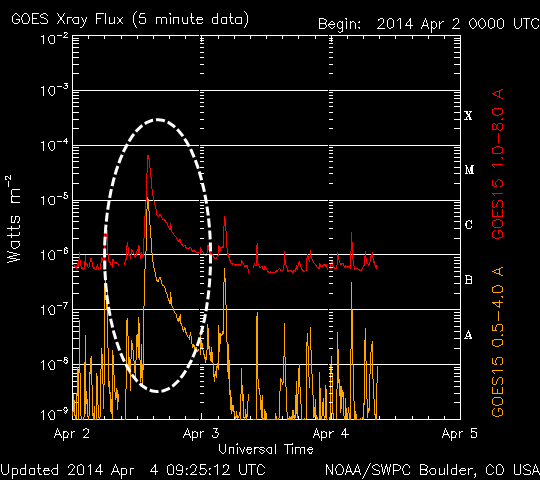Space Weather Alert - 4 April 2014
What Has Happened?
A series of coronal mass ejections (CMEs) have left the Sun this week, so an increase in geomagnetic activity is expected over the next few days.
A slow faint CME left the Sun on 1 April. Whilst this was aimed quite directly at Earth its speed and intensity made it unlikely to cause much geomagnetic activity on its own.
However, on the evening of 2 April, the Sun launched a much brighter and faster CME. This was associated with a moderate strength (M6.5) but long duration X-ray flare. The bulk of this second CME is heading north and east; but there is a not insignificant Earth directed component.
Parts of the second CME are likely to catch up to and combine with the bulk of the first event. Particles swept up in front of CMEs can give advanced warning that they are going to strike Earth. Data from the ACE spacecraft show just such a snow-plough effect at the moment. This suggests that the interacting CMEs will hit Earth within the next 24 hours. Increased geomagnetic activity and periods of storm conditions are possible for the next few days.
Assuming clear dark skies, there is an increased chance of seeing the aurora in the hours following the arrival of the CMEs, particularly at high latitudes in the North of Scotland.
Sign-up to receive Geomagnetic Disturbance Alert emails.
Follow us on Twitter:
Follow @BGSauroraAlert for more occasional aurora alerts.
Follow @BGSspaceWeather for daily space weather forecasts.
Glossary
- BGS
- The British Geological Survey is one of the Natural Environment Research Council's Research Centres.
CME or Coronal Mass Ejection- The eruption of a portion of the outer atmosphere of the Sun into space, caused by rapid changes in its magnetic field. Often occurs along with a solar flare.
- Solar Flare
- Energy released by the explosive reorganisation of magnetic fields within the Sun's atmosphere.
Solar Wind- The ever-present expansion of the Sun’s hot outer atmosphere into the solar system, which carries space weather within it.
Sunspot- A region of intense magnetic field in the Sun's visible outer atmosphere often associated with flares and CMEs.




